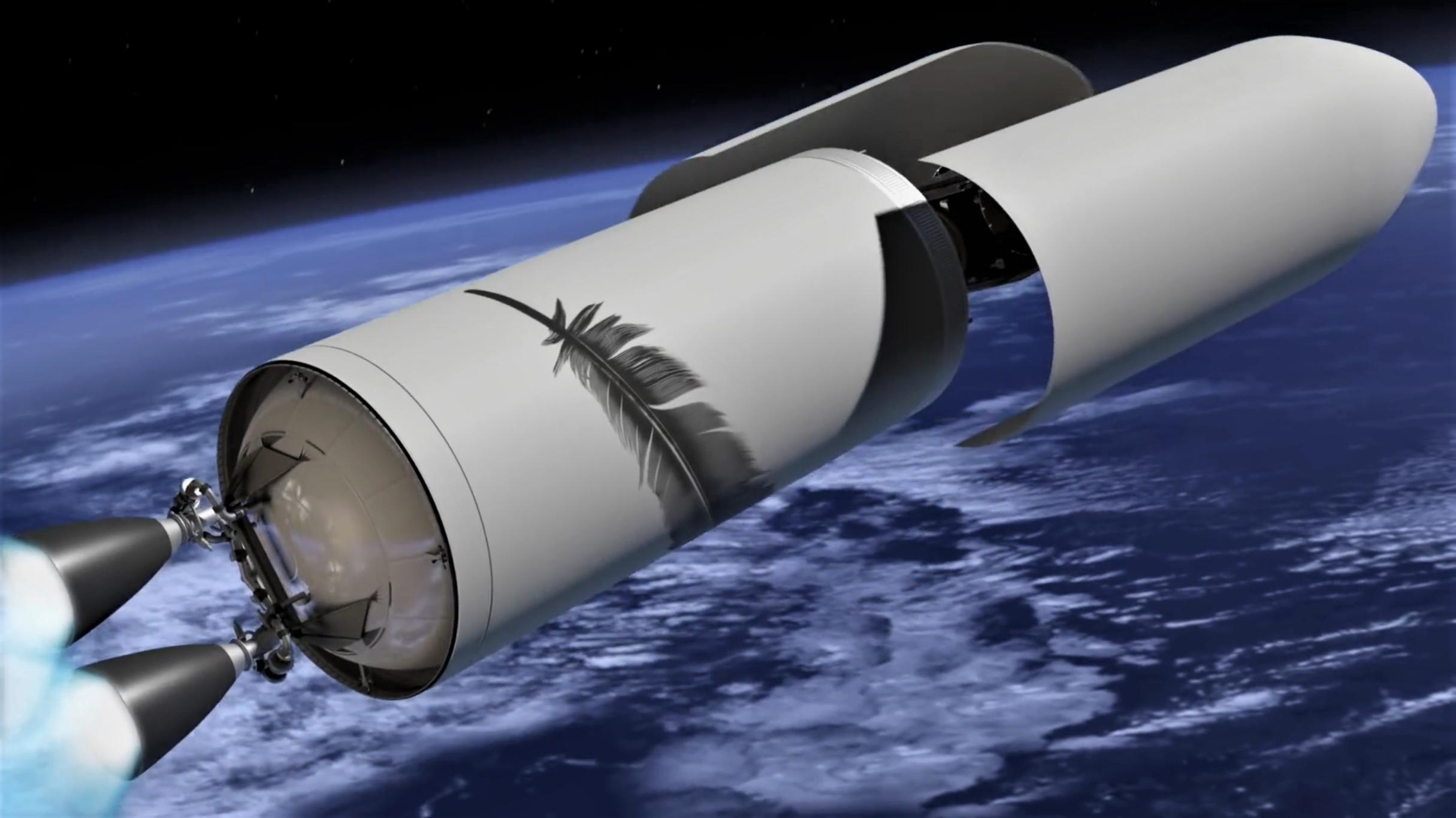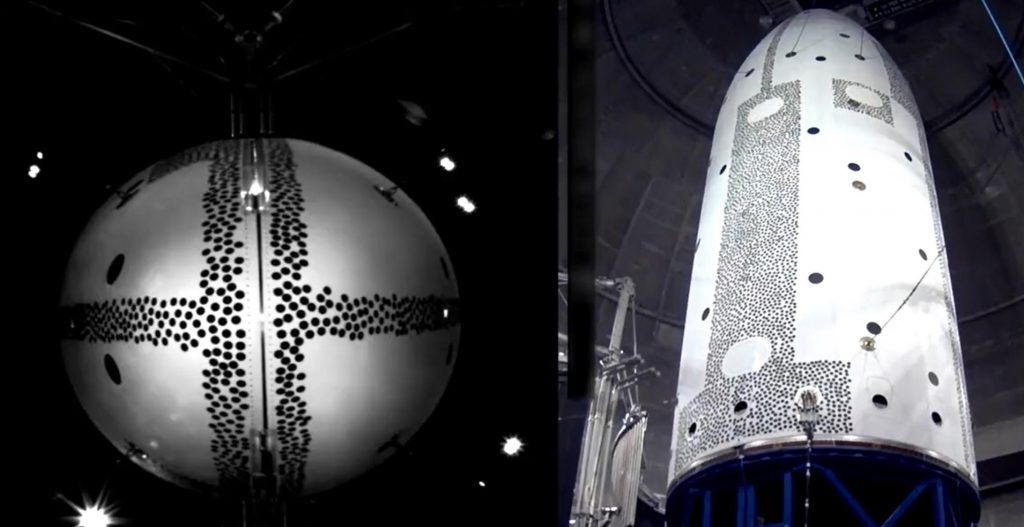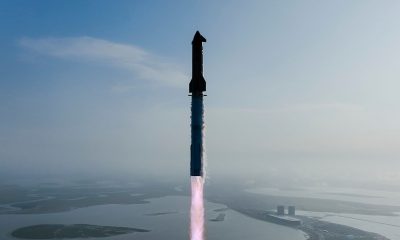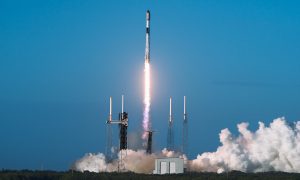

News
Blue Origin successfully tests first New Glenn fairing prototype
Blue Origin has completed a crucial test of the payload fairing of their upcoming New Glenn rocket at NASA’s Armstrong Test Facility in Ohio.
The fairing – also known as a nose cone – encapsulates payloads and insulates them from the local environment and the stress of ascent. During ascent, it must protect the payload from aerodynamic buffeting and heating as the rocket works to escape Earth’s atmosphere. The purpose of Blue Origin’s test was to ensure that the fairing’s halves properly separate and jettison, exposing the payload to the vacuum of space and preparing it for deployment minutes or hours later. Equally important is ensuring that those fairing halves are pushed far enough away from the rocket to avoid recontact, which could easily cause catastrophic damage.

New Glenn is set to be Blue Origin’s first orbital launch vehicle and is designed to launch at up to 45 metric tons (~100,000 lb) to low Earth orbit (LEO) and almost 14 tons (~30,000 lb) to geostationary transfer orbit (GTO) – very similar to the performance offered by a SpaceX Falcon Heavy with full recovery of all three boosters. Set to stand approximately 96 meters (313 ft) tall, New Glenn improves upon the multi-core complexity of Falcon Heavy with a simpler single-core design. Similar to SpaceX’s single-core Falcon 9, New Glenn features a fully reusable first stage pair, an expendable upper stage, and the world’s largest composite payload fairing (likely also expendable). New Glenn will launch from Cape Canaveral Space Force Station (CCSFS) Launch Complex 36 (LC-36) – barely a mile south of the land-based Landing Zones some Falcon boosters land at.
This test took place at NASA Glenn Research Center’s Armstrong Test Facility Space Environments Complex. The complex is home to the world’s largest vacuum chamber. “This is the only place in the world that we can test out this fairing in an environment similar to what the rocket will be seeing in space,” stated Shawna Sherwood Ryan, Project Manager and Test Coordinator for Blue Origin. SpaceX used the same facility to test the deployment performance of its first 5.2-meter-wide (~17 ft) Falcon fairing prototype in the early 2010s.
In a video released by Blue Origin on Monday, February 1st, what amounts to the first integrated New Glenn hardware test of any kind proved successful. “This is a very exciting day,” said Park Cover, Sr. Director of New Glenn Stage 2 & Payload Accommodations. Blue Origin is likely still years away from New Glenn’s first orbital launch attempt but this test provides some confidence that the company is finally entering the integrated testing phase of launch vehicle development.
The fairing is perhaps the simplest large assembly of any orbital launch vehicle and Blue Origin has yet to reveal any evidence of work on integrated booster or upper stage test hardware, but successfully completing the most important part of fairing qualification nonetheless raises the odds that New Glenn’s first launch could happen sometime next year. As of February 2021, the company claimed that New Glenn’s launch debut could happen as early as “late 2022.”
News
Tesla begins Robotaxi certification push in Arizona: report
Tesla seems serious about expanding its Robotaxi service to several states in the coming months.

Tesla has initiated discussions with Arizona transportation regulators to certify its driverless Robotaxi service in the state, as per a recent report from Bloomberg News. The move follows Tesla’s launch of its Robotaxi pilot program in Austin, Texas, as well as CEO Elon Musk’s recent comments about the service’s expansion in the Bay Area.
The Arizona Department of Transportation confirmed to Bloomberg that Tesla has reached out to begin the certification process for autonomous ride-sharing operations in the state. While details remain limited, the outreach suggests that Tesla is serious about expanding its driverless Robotaxi service to several territories in the coming months.
The Arizona development comes as Tesla prepares to expand its service area in Austin this weekend, as per CEO Elon Musk in a post on X. Musk also stated that Tesla is targeting the San Francisco Bay Area as its next major market, with a potential launch “in a month or two,” pending regulatory approvals.
Tesla first launched its autonomous ride-hailing program on June 22 in Austin with a small fleet of Model Y vehicles, accompanied by a Tesla employee in the passenger seat to monitor safety. While still classified as a test, Musk has said the program will expand to about 1,000 vehicles in the coming months. Tesla will later upgrade its Robotaxi fleet with the Cyercab, a two-seater that is designed without a steering wheel.
Sightings of Cybercab castings around the Giga Texas complex suggests that Tesla may be ramping the initial trial production of the self-driving two-seater. Tesla, for its part, has noted in the past that volume production of the Cybercab is expected to start sometime next year.
In California, Tesla has already applied for a transportation charter-party carrier permit from the state’s Public Utilities Commission. The company is reportedly taking a phased approach to operating in California, with the Robotaxi service starting with pre-arranged rides for employees in vehicles with safety drivers.
News
Tesla sets November 6 date for 2025 Annual Shareholder Meeting
The automaker announced the date on Thursday in a Form 8-K.

Tesla has scheduled its 2025 annual shareholder meeting for November 6, addressing investor concerns that the company was nearing a legal deadline to hold the event.
The automaker announced the date on Thursday in a Form 8-K submitted to the United States Securities and Exchange Commission (SEC). The company also listed a new proposal submission deadline of July 31 for items to be included in the proxy statement.
Tesla’s announcement followed calls from a group of 27 shareholders, including the leaders of large public pension funds, which urged Tesla’s board to formally set the meeting date, as noted in a report from The Wall Street Journal.
The group noted that under Texas law, where Tesla is now incorporated, companies must hold annual meetings within 13 months of the last one if requested by shareholders. Tesla’s previous annual shareholder meeting was held on June 13, 2024, which placed the July 13 deadline in focus.
Tesla originally stated in its 2024 annual report that it would file its proxy statement by the end of April. However, an amended filing on April 30 indicated that the Board of Directors had not yet finalized a meeting date, at least at the time.
The April filing also confirmed that Tesla’s board had formed a special committee to evaluate certain matters related to CEO Elon Musk’s compensation plan. Musk’s CEO performance award remains at the center of a lengthy legal dispute in Delaware, Tesla’s former state of incorporation.
Due to the aftermath of Musk’s legal dispute about his compensation plan in Delaware, he has not been paid for his work at Tesla for several years. Musk, for his part, has noted that he is more concerned about his voting stake in Tesla than his actual salary.
At last year’s annual meeting, TSLA shareholders voted to reapprove Elon Musk’s compensation plan and ratified Tesla’s decision to relocate its legal domicile from Delaware to Texas.
Elon Musk
Grok coming to Tesla vehicles next week “at the latest:” Elon Musk
Grok’s rollout to Tesla vehicles is expected to begin next week at the latest.

Elon Musk announced on Thursday that Grok, the large language model developed by his startup xAI, will soon be available in Tesla vehicles. Grok’s rollout to Tesla vehicles is expected to begin next week at the latest, further deepening the ties between the two Elon Musk-led companies.
Tesla–xAI synergy
Musk confirmed the news on X shortly after livestreaming the release of Grok 4, xAI’s latest large language model. “Grok is coming to Tesla vehicles very soon. Next week at the latest,” Musk wrote in a post on social media platform X.
During the livestream, Musk and several members of the xAI team highlighted several upgrades to Grok 4’s voice capabilities and performance metrics, positioning the LLM as competitive with top-tier models from OpenAI and Google.
The in-vehicle integration of Grok marks a new chapter in Tesla’s AI development. While Tesla has long relied on in-house systems for autonomous driving and energy optimization, Grok’s integration would introduce conversational AI directly into its vehicles’ user experience. This integration could potentially improve customer interaction inside Tesla vehicles.
xAI and Tesla’s collaborative footprint
Grok’s upcoming rollout to Tesla vehicles adds to a growing business relationship between Tesla and xAI. Earlier this year, Tesla disclosed that it generated $198.3 million in revenue from commercial, consulting, and support agreements with xAI, as noted in a report from Bloomberg News. A large portion of that amount, however, came from the sale of Megapack energy storage systems to the artificial intelligence startup.
In July 2023, Musk polled X users about whether Tesla should invest $5 billion in xAI. While no formal investment has been made so far, 68% of poll participants voted yes, and Musk has since stated that the idea would be discussed with Tesla’s board.
-

 Elon Musk1 week ago
Elon Musk1 week agoTesla investors will be shocked by Jim Cramer’s latest assessment
-

 Elon Musk20 hours ago
Elon Musk20 hours agoxAI launches Grok 4 with new $300/month SuperGrok Heavy subscription
-

 Elon Musk3 days ago
Elon Musk3 days agoElon Musk confirms Grok 4 launch on July 9 with livestream event
-

 News7 days ago
News7 days agoTesla Model 3 ranks as the safest new car in Europe for 2025, per Euro NCAP tests
-

 Elon Musk2 weeks ago
Elon Musk2 weeks agoA Tesla just delivered itself to a customer autonomously, Elon Musk confirms
-

 Elon Musk1 week ago
Elon Musk1 week agoxAI’s Memphis data center receives air permit despite community criticism
-

 Elon Musk2 weeks ago
Elon Musk2 weeks agoTesla’s Omead Afshar, known as Elon Musk’s right-hand man, leaves company: reports
-

 News2 weeks ago
News2 weeks agoXiaomi CEO congratulates Tesla on first FSD delivery: “We have to continue learning!”

















